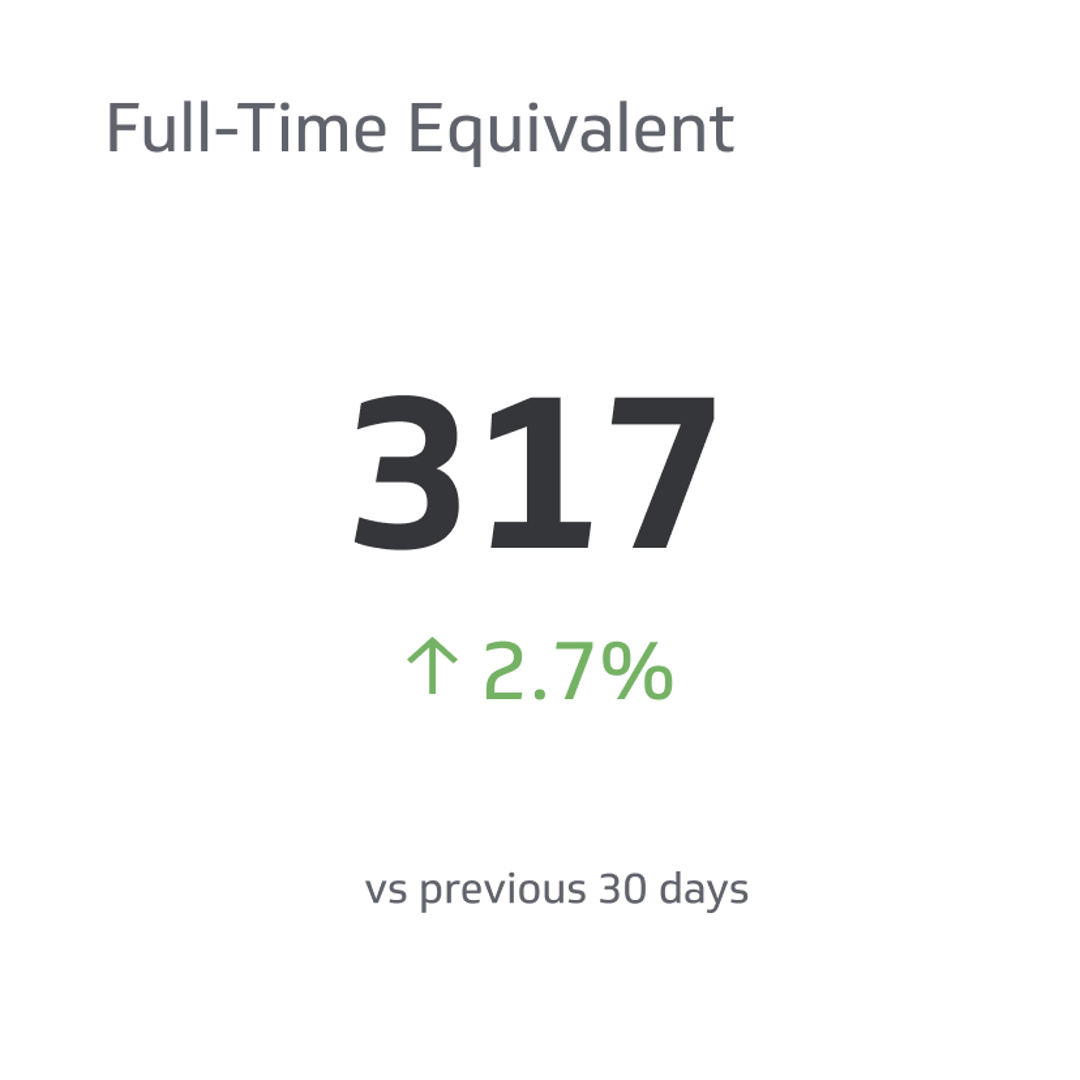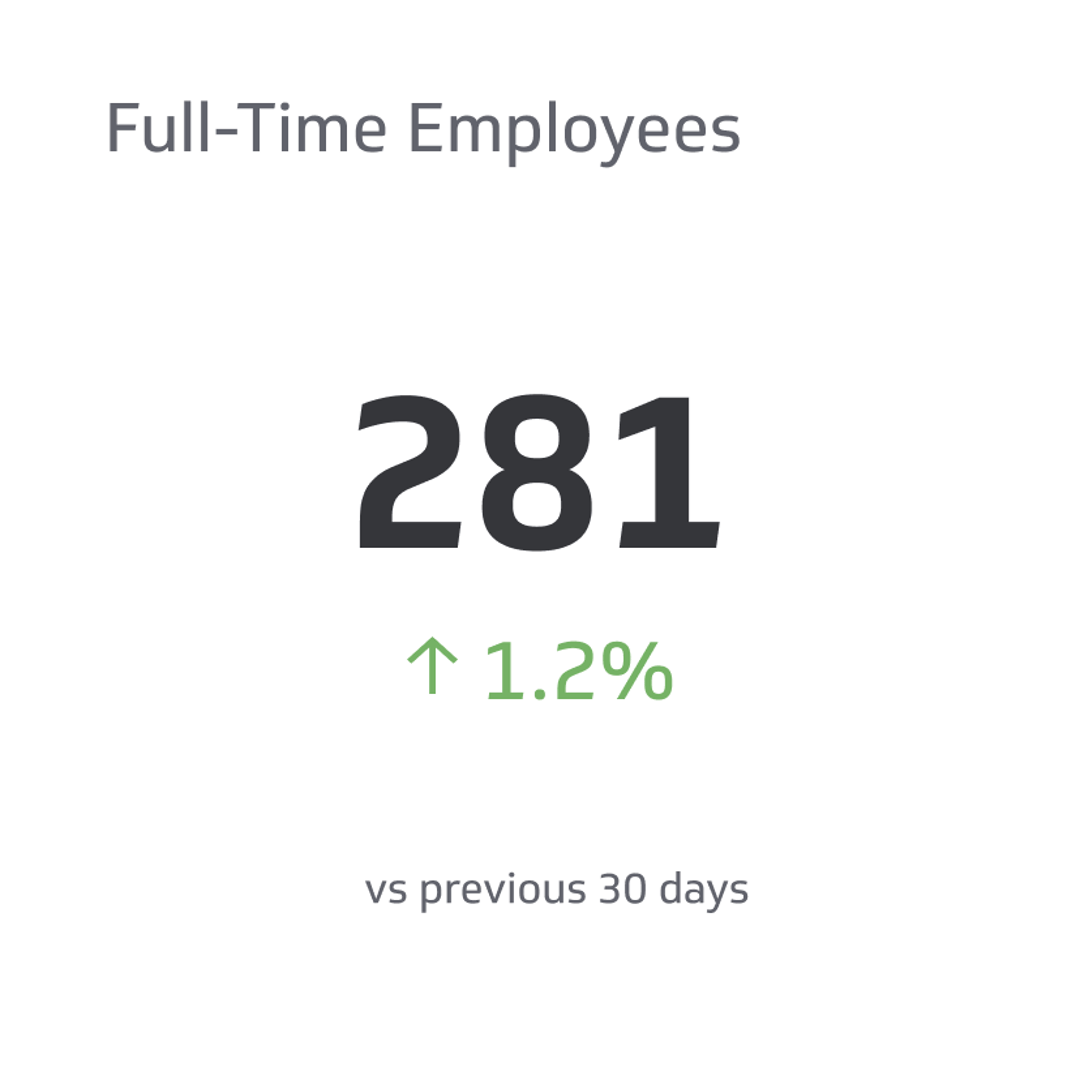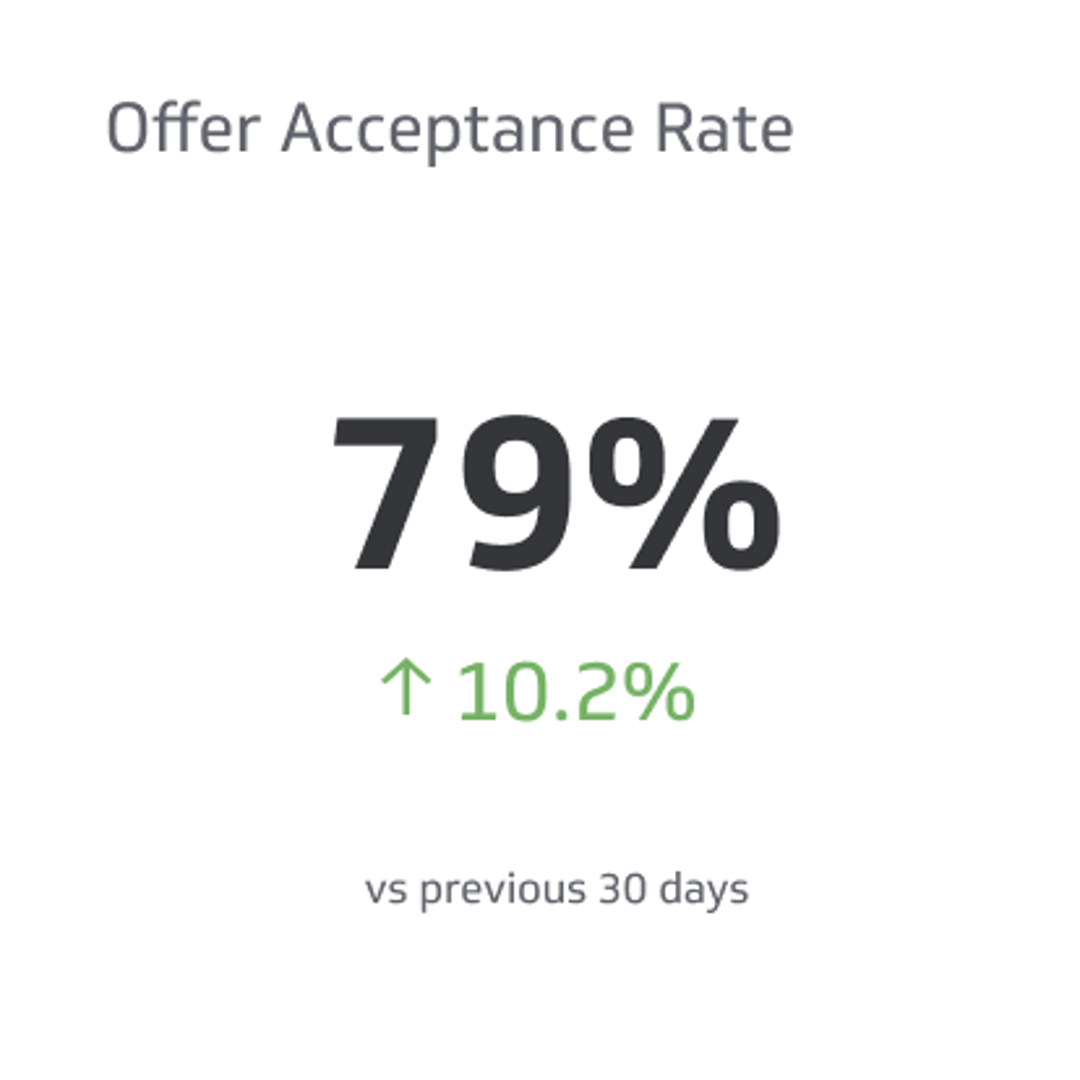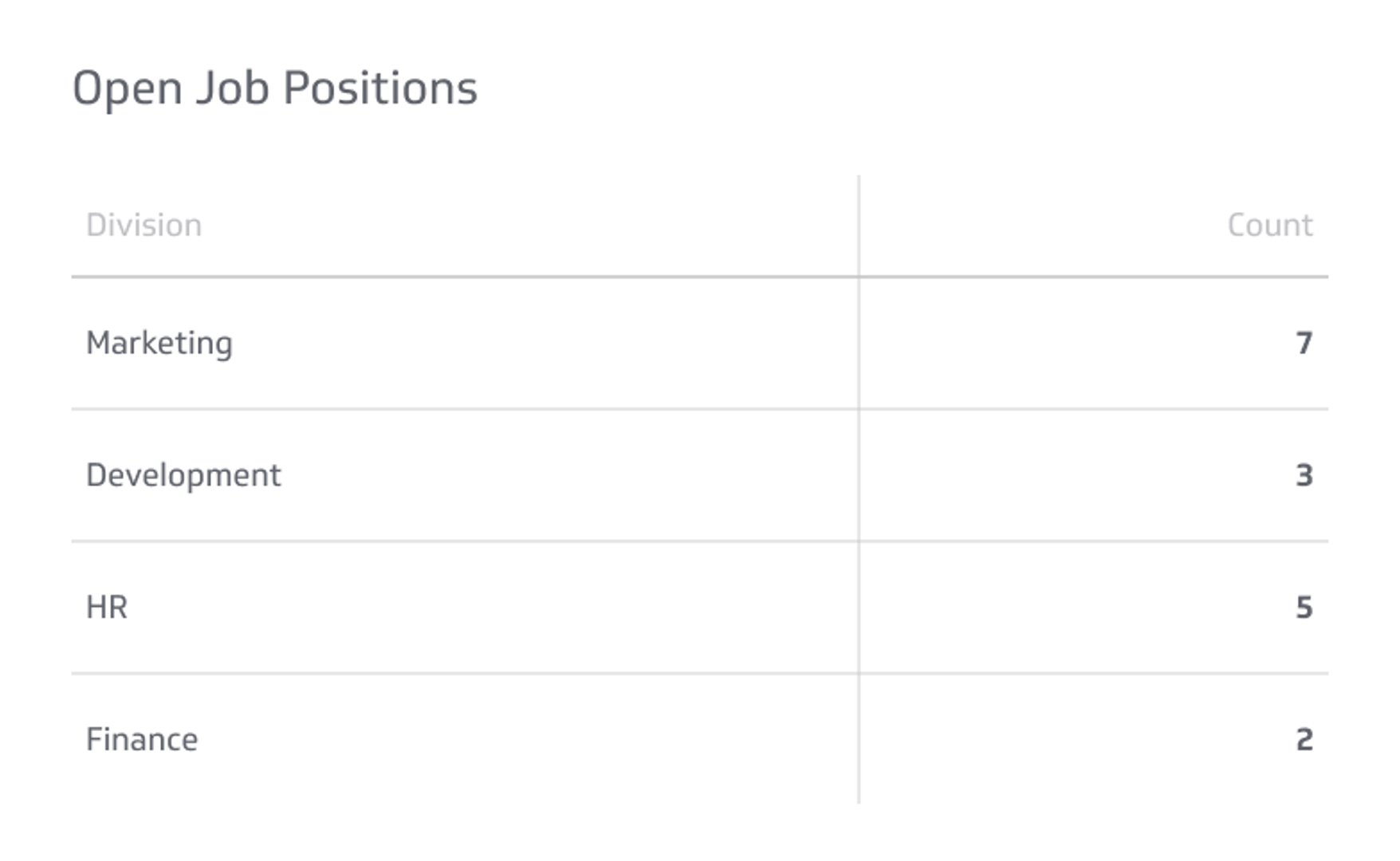Full-Time Equivalent (FTE)
Full-time equivalent is a measurement that defines a unit of work that your company standardizes as “full-time.”
Track all your HR KPIs in one place
Sign up for free and start making decisions for your business with confidence.

Calculating full-time equivalent (FTE) hours for a business has many benefits, but why does it matter, and how do you do it? In this cohesive guide, you’ll learn everything you need to know about FTE and how using it can help your business flourish.
What Is Full-Time Equivalent?
Full-time equivalent is a measurement that defines a unit of work that your company standardizes as “full-time.” For most businesses, this is 40 hours, although for legal purposes (like the Affordable Care Act), FTE may be set to 30 hours instead.
In this context, an employee who works 20 hours a week would be 0.5 FTE, while someone who works 10 hours would be 0.25 FTE. If someone works overtime, they may be 1.5 FTE for 60 hours.
FTE is about 2,080 hours annually at most businesses, although this can vary at specific companies.
Calculating Full-Time Equivalent
The best way to calculate your full-time equivalent is to get a comprehensive look at hours across your company, as follows.
Step 1: List Employees and Hours
Get a list of all of your employees who receive W-2 tax forms. Once you have that, determine their total number of hours worked each, excluding any leave (usually paid or sick leave).
Only include 1099 contractors in your calculations. They are not employees, and their hours worked don’t count toward your FTE. Also, most of them don’t report their hours to you, so you may not have a way of checking them regardless.
Step 2: Define Your FTE
Once you have your number of hours and a list of all employees, it’s time to decide how to calculate your FTE. Most employers use either 30 or 40 hours for this.
Larger employees (50 FTE or more) typically use 30 hours as full-time because that’s the threshold for some benefits. Smaller companies are more likely to use 40 hours, the standard work week.
Many companies only offer benefits to employees who are effectively full-time, so knowing your threshold for who qualifies and who doesn’t is also important.
Step 3: Calculate Annual Hours Worked
Once you’ve decided how many hours a full-time equivalent position is at your business, multiply that number by 52 (the number of weeks in a year) to get the number of hours one full-time equivalent employee would work.
At 30 hours per week, this is 1560 hours annually.
At 40 hours per week, it’s 2080 hours of work instead.
Step 4: Calculate Your Total Hours Worked
Add up the work hours of all full-time and part-time employees. After listing your employees and their work hours in the first step, you should have all the numbers you need.
Step 5: Calculate Your FTE
Once you have your total hours worked, divide that by the number of hours in a full-time role.
For example, if you have 15,220 hours worked and decide full-time is 40 hours per week, 15,220 / 2080 = 7.31 FTE. If you’ve budgeted for 8 FTE, you now know you could hire up to about 0.69 FTE with no issues.
The Benefits Of Full-Time Equivalent
Using FTE has several direct benefits for businesses.
Budgeting
FTE is an effective way to help budget tasks. For example, based on experience, you may know that running a marketing campaign for your company will cost you about 4.5 FTE while it’s in progress.
You can also perform calculations like revenue per FTE. This calculation is not a linear number at most businesses where more FTE equals a specifically higher profit. However, calculating your revenue at various staffing levels can help you determine the optimal number of hours or employees at any time.
In some cases, FTE can also help you better understand how quickly you can accomplish specific tasks. This approach isn’t suitable for every situation (hiring ten drivers won’t make a single delivery ten times faster, though you could ship ten times as much in the same timeframe), but in cases where more hands help, you can figure out labor costs better.
Workload
FTE is an effective way to help determine how many full-time or part-time employees you can hire. This technique is also helpful for managing schedules and tracking output as part-time hours for employees change.
For example, let’s say your budget allows for 10 FTE in a store you’re running. Looking over your needs, you decide to set 3 FTE for managers. One person is truly full-time, and you have three more managers who are 0.66 FTE each and rotate throughout the week, so you have coverage on the weekends.
At this point, you have 7 FTE left over for your work. You decide to offer up to 20 hours each for part-time workers, so you end up hiring 14 people that your managers oversee.
After a few weeks of business, one of your part-time workers quits, citing another opportunity. You decide to offer their hours to the highest-performing part-time employee, who accepts, becoming a full-time employee. You’re still paying out the same 7 FTE for non-managerial staff, but your exact proportion of hours within this framework is flexible.
For most businesses, the goal is to minimize the expenses and necessary workload while considering that shrinking too far can ultimately damage the business.
Hiring Considerations
Hiring considerations are similar to workload but focus specifically on how and when you decide to hire new employees. There are a few crucial factors to consider here.
First, most places need to offer a minimum number of hours for most workers to consider the job worth it. You can get away with smaller schedules if you have limited hours and mostly hire students, but anything too low and you may have difficulty getting anyone.
Second, FTE can help you decide whether hiring a part-time or full-time worker makes more sense. Which option makes more sense depends on the kind of business you’re running, but full-time employees tend to be more reliable and capable than part-time ones.
Are There Any Drawbacks To Using FTE?
Full-time equivalent is an effective measurement for most businesses because it helps simplify costs and makes it easier to understand how hiring, overtime, and similar matters may affect budgets.
However, relying entirely on this model can make it easy to overlook other expenses, which can result in exceeding your budget.
For example, if you’re hiring four employees at 0.25 FTE, you have to expend four times as many resources to onboard and train them. That may not be a massive deal at some companies, but it’s significantly more work hours before everyone operates at the right level.
Focusing too much on FTE can also make it harder to balance people’s schedules and keep them happy with their work.
Let’s say you have a business open five days a week for eight hours, with an additional hour before and after opening for cleaning, setup, and other tasks. Due to the needs of your business, you need 50 work hours per day you’re open, for a total of 250 work hours you can give to people each week, or a little over 6 FTE.
Hiring and having many people can make it difficult to juggle their schedules and give everyone the time they want. That increases the risk of people calling out or quitting and limits potential coverage from other employees.
You may theoretically have enough employees to provide enough hours, but realistically, your 7 FTE of coverage between employees may end up being closer to 4 or 5.
That’s not good when you need 6 FTE, so it may be better to fire a few people and increase hours for others. Remember, employees are not robots, and expecting them to adjust their lives at any moment rarely works as well in practice as in theory.
Frequently Asked Questions
Here are some common questions that people have about full-time equivalent calculations.
What is FTE 100%?
FTE 100% means an employee who works precisely the hours necessary to be a full-time employee. This timing is usually 30 or 40 hours, depending on the company.
Allowing overtime means that an employee can go over this number. Some companies accept or even encourage this, while others do not.
How do benefits factor into all of this?
Generally, full-time employees have more and better benefits than part-time workers and contractors. This factor means that the actual cost of an FTE 100% employee can be higher than having twice as many 0.5 FTE employees, even after counting things like onboarding and hiring expenses.
The most important thing to remember is that either option may work for a business.
Outside of those required by law, benefits are mainly a way to attract and retain employees by offering them something outside their salary. High-quality employees are more productive than lower-quality ones, so they can often earn more for the company despite their higher pay.
As long as you budget appropriately, benefits should not significantly impact your FTE calculations. One option is to create a separate fund for benefits and measure new offerings against that. If you’re close to your limit for the amount you’re willing to spend on benefits across employees, it may be better to hire part-time employees.
What about overtime?
Overtime usually means hours in a workweek that go above FTE, so part-time employees aren’t necessarily doing overtime even if they work a little more than you originally scheduled.
Overtime is sometimes necessary for companies to get projects done on time, but excessive overtime usually indicates that a company has too few employees.
Overtime hours are usually at least 1.5x the cost of a regular hour. For example, if someone works 60 hours per week at a 40-hour FTE business, the company is functionally paying for 70 hours of work even though it’s only getting 60 hours of progress. That means a single employee costs about 1.75 FTE from your budget.
You can usually get the same amount of work hours at a lower cost by hiring more employees, though this can get tricky if you’re close to the 50 FTE cutoff for medical benefits and don’t want to go over that line.
However, some jobs require specialist performance that you can’t easily hire others for. In these cases, paying out overtime may be the only practical option. Similarly, hiring too many more employees can disrupt teams and cause project delays, so it’s not as simple as “overtime bad, hiring good.”
Some people prefer not to calculate overtime for FTE, in which case 1.0 is the highest an employee can ever be.
What about adjusting FTE?
Many companies adjust their staffing levels throughout the year depending on expected demand. For example, retail companies typically see higher sales in December but may have fewer people in the store over autumn.
Once you’ve been in business for a while, you should have a good sense of seasonal highs and lows at your business. Depending on your needs, you can hire more employees or adjust hours for current employees to maintain an optimal ratio for that period.
As a rule, adjusting hours for existing employees is more manageable than hiring someone new. Most people are willing to accept more hours (up to 40), especially if you can offer benefits to go with it. However, some businesses want to avoid offering benefits for only a few months, so hiring more workers may be more affordable.
One option here is hiring employees with enough flexible schedules to accept ups and downs throughout the year. Depending on the size of your business, you may get by with just one or two people with very flexible schedules, while everyone else is primarily fixed.
Final Thoughts
Full-time equivalent remains one of the most helpful HR metrics for businesses. While it has a few limitations to keep in mind, its overall value is providing a fast, simple way to understand your flexibility, income, and expenses for the number of hours your employees work.
Related Metrics & KPIs



